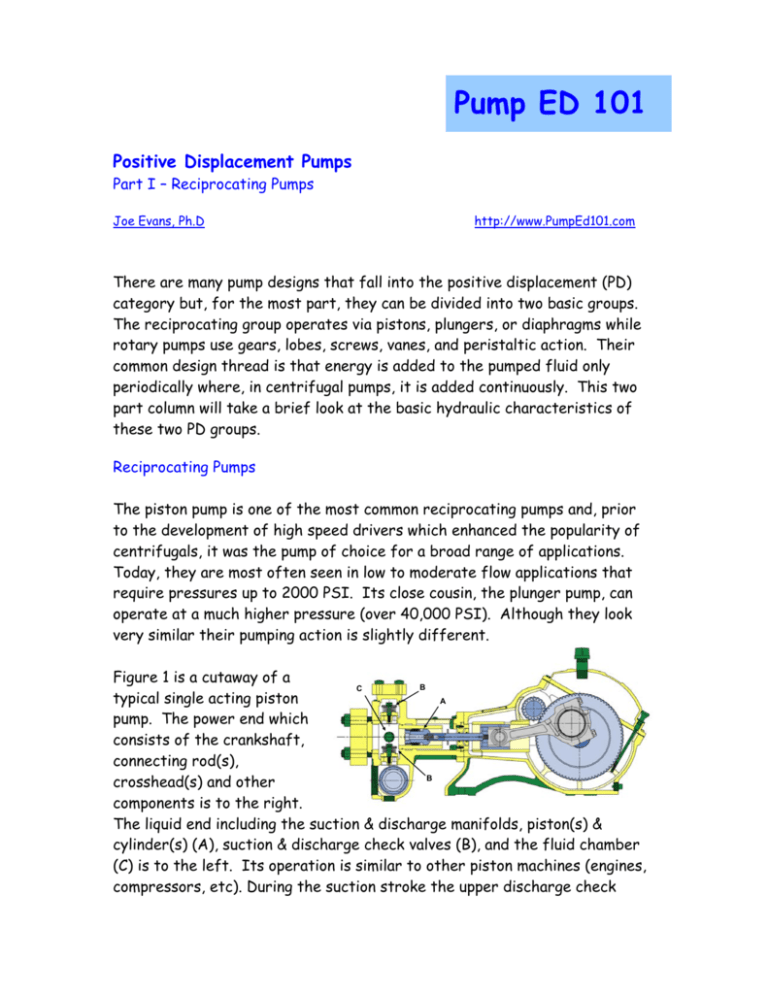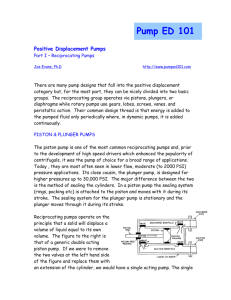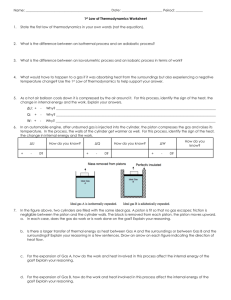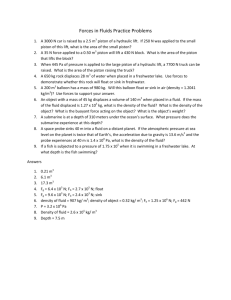THE PUZZLER - Pump Ed 101
advertisement

Pump ED 101 Positive Displacement Pumps Part I – Reciprocating Pumps Joe Evans, Ph.D http://www.PumpEd101.com There are many pump designs that fall into the positive displacement (PD) category but, for the most part, they can be divided into two basic groups. The reciprocating group operates via pistons, plungers, or diaphragms while rotary pumps use gears, lobes, screws, vanes, and peristaltic action. Their common design thread is that energy is added to the pumped fluid only periodically where, in centrifugal pumps, it is added continuously. This two part column will take a brief look at the basic hydraulic characteristics of these two PD groups. Reciprocating Pumps The piston pump is one of the most common reciprocating pumps and, prior to the development of high speed drivers which enhanced the popularity of centrifugals, it was the pump of choice for a broad range of applications. Today, they are most often seen in low to moderate flow applications that require pressures up to 2000 PSI. Its close cousin, the plunger pump, can operate at a much higher pressure (over 40,000 PSI). Although they look very similar their pumping action is slightly different. Figure 1 is a cutaway of a B C typical single acting piston A pump. The power end which consists of the crankshaft, connecting rod(s), B crosshead(s) and other components is to the right. The liquid end including the suction & discharge manifolds, piston(s) & cylinder(s) (A), suction & discharge check valves (B), and the fluid chamber (C) is to the left. Its operation is similar to other piston machines (engines, compressors, etc). During the suction stroke the upper discharge check valve closes and allows the piston to draw fluid into the cylinder through the lower suction valve. When the piston changes direction (reciprocates) the suction valve closes and the fluid is forced out of the cylinder through the discharge valve. Like other piston based machines the sealing rings move with the piston. Some piston pumps use a different valve design that allows water to enter the rear of the cylinder during the discharge stroke. During the back stroke it is transferred to the front side of the piston via a check valve and is forced out during the discharge stroke. The single acting pump discharges water only on its forward stroke. A more complex design, known as the double acting pump, allows the piston to discharge fluid during both its forward and back stroke, resulting in almost twice the flow per cycle. B Figure 2 is a cutaway of a plunger pump. The power end is very similar to the one seen in Figure 1 but there are two C distinct differences in the A B liquid end. The piston is replaced with a plunger that is sealed by stationary sealing rings (A). Also, there is no cylinder - - just a fluid chamber (C) between the check valves (B). Plunger pumps operate on the principle that a solid will displace a volume of liquid equal to its own volume. Instead of forcing the liquid out of a cylinder via a piston, the plunger enters the fluid chamber and displaces an amount of liquid equal to the plunger volume entering the chamber. Pressure The head created by a centrifugal pump depends upon the velocity it imparts to a fluid via its impeller. Therefore, for any given impeller diameter and rotational speed, head will always be some calculated maximum. Not so for reciprocating pumps. Although they will have a maximum operating pressure rating, the maximum pressure (P) attained depends upon the compressibility of the liquid, and the application in which the pump resides. For example, when pumping water against a closed valve, the maximum pressure generated depends upon the capacity of the driver and the strength of the materials that make up the power and liquid ends. Only the “breaking point” of some component will limit discharge pressure. Therefore some form of pressure relief must be supplied if an application is capable of exceeding the pressure rating of the pump or the system in which it is installed. Capacity The capacity (Q) of a single acting piston or plunger pump is proportional to its displacement (D) per unit time. The displacement is the calculated capacity of the pump, assuming 100% hydraulic efficiency, and is proportional to the cross sectional area of the piston (A), the length of its stroke (s), the number of cylinders (n), and the pump’s speed in rpm. In gallons per minute it is: D = (A x s x n x rpm) / 231 In the case of double acting pumps the cross sectional area of the piston is doubled and the cross sectional area of the piston rod (a) is subtracted. Again, in gallons per minute displacement is: D = ((2A - a) x s x n x rpm) / 231 In real life the theoretical capacity of a piston or plunger pump is tempered by several factors. One is known as slip (S). The major component of slip is the leakage of fluid back through the discharge or suction valves as during closing. Slip can reduce calculated displacement from 2 to 10% depending upon valve design and condition. Fluid viscosity can also have an effect on slip and, as a rule of thumb, higher viscosities will increase slip. Another important factor that affects a reciprocating pump’s capacity is its volumetric efficiency (VE). VE is expressed as a percentage and is proportional to the ratio of the total volume of the cylinder (or plunger) and fluid chamber to the piston or plunger displacement. If you take another look at Figures 1 & 2, you will note that a certain amount of liquid will remain in the chamber between the suction and discharge valves at the end of the discharge stroke. The ratio (r) is calculated by “(c + d) / d” where “d” is the volume displaced by the piston or plunger and “c” is the additional volume of the fluid chamber. Depending upon the compressibility of a liquid, the “c” volume can have a significant effect upon the actual displacement volume. Therefore, volumetric efficiency decreases with an increase in the “c+d/d” ratio. Expressed mathematically, it looks like this: VE = 1 - (P x b x r) - S where P is pressure, b is the liquid’s compressibility factor, r is the volume ratio, and S is slip. The compressibility factor for water is quite small but at higher pressures it does become a factor. Other liquids such as butane and propane have significantly higher compressibility factors. Now, we can finally state the actual capacity of a reciprocating pump. It is quite simply: Q = D x VE Power The power required to drive a reciprocating pump is also quite straight forward. It is directly proportional to pressure and capacity and inversely proportional to the mechanical efficiency of the pump. In brake horsepower it is: bhp = (Q X P) / (1714 X ME) where 1714 is the bhp conversion factor and ME is mechanical efficiency. Mechanical efficiency is the percentage of the driver power that is not lost in the pump’s power frame and other reciprocating parts. The mechanical efficiency of a piston or plunger pump ranges between 80 and 95% depending upon speed, size, and construction. Joe Evans is responsible for customer and employee education at PumpTech Inc, a pumps & packaged systems manufacturer & distributor with branches throughout the Pacific Northwest. He can be reached via his website www.PumpEd101.com. If there are topics that you would like to see discussed in future columns, drop him an email.






